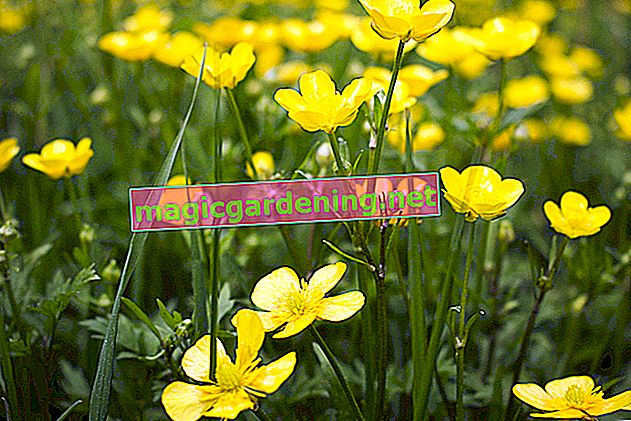
Buttercup - A wanted poster
- botanical name: Ranunculus
- popular name: buttercup
- Kinds: over 600 kinds
- Family: buttercups
- Origin: native plant
- Occurrence: worldwide except Antarctica
- Location: damp meadows, compacted areas
- Annual / perennial: perennial
- Propagation: seeds, runners
- Height: 30 to 60 centimeters
- Flower color: yellow, shiny
- Flower structure: radial, 15 - 25 mm wide, 5 leaved, many-flowered
- Flowering period: June to September
- Leaves: green, depending on the variety, smooth, notched, toothed or serrate
- Fruits: follicles or nuts
- Toxicity: yes, in all parts of the plant
Where does the buttercup get its name from?
The name buttercup refers to the leaves that resemble the feet of birds. It is called buttercup because of the yellow petals that are the color of fresh butter.
also read
- The flowering time of buttercup depends on the variety
- This is what a buttercup flower looks like
- Buttercup is poisonous to humans and animals
The botanical name Ranunculus comes from Latin and means frog. It is probably due to the preferred location of most buttercup species, namely moist locations - precisely where frogs also live.
Frequently occurring species in Germany
- Sharp buttercup
- Burning buttercup
- Bulbous buttercup
- Poison buttercup
The sharp buttercup is particularly common. It is characterized by small flowers. It can be found on wet meadows and at the edges of ponds.
For gardeners, buttercup was one of the weeds, as the plant spreads rapidly through seeds and runners. It can hardly be driven out of the garden and especially from lawns. Buttercup is valued only on garden ponds for its pretty yellow flowers.
Rooster clover is only grown as a cultivated plant in the garden bed. These cultivars are characterized by large flowers and not quite as vigorous.
Tips
Buttercup was originally a medicinal plant. Due to the poisonous protoanemonin it contains, the plant is indigestible and is therefore only used in homeopathy. The sap is already toxic on contact and can cause buttercup dermatitis.








